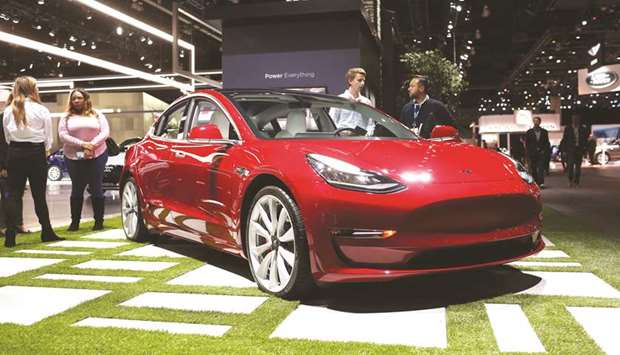Electric vehicle owners – nearly 1.2mn of them on United States roads today – share the thrills of being energy-efficient and progressive. But they also have one big worry in common: where to plug in.
Depending on the state, access to public charging stations can be adequate – or nearly nonexistent.
Purchases of electric vehicles are growing at an astronomical rate – an 81% increase from 2017 to 2018, according to the Edison Electric Institute, which tracks electricity use – and nothing indicates the trend will slow dramatically any time soon. But if anything could stunt the growth, it’s the lack of power charging stations in some states.
Drivers can experience “range anxiety” wondering how far they can drive before the next charge and where to find a station before the car dies. It’s the electric vehicle equivalent of driving a traditional car on an isolated country road with the gas gauge hovering near empty.
Many states want to encourage electric vehicle use to reduce carbon emissions and tackle climate change. But ensuring that there are enough charging stations has been a challenge. Some states provide incentives for private investment, while others are relying on millions from a settlement with Volkswagen over its falsification of emissions tests to subsidise the building of commercial charging stations.
In addition, state utilities have just begun to cope with how to regulate the power supplied by the chargers by setting cost per kilowatt, peak charges and subsidies.
Legislatures in Colorado, Washington, California and New Mexico passed laws in 2019 calling on state utility boards to write rules governing electric charging stations to encourage EV adoption. In New Jersey, a bill to incentivise electric car buying and installation of charging stations passed a Senate committee in December with just one vote in opposition. Other states also are considering bills addressing electric vehicles and charging stations.
Electric vehicles used for short commutes can be plugged in at home daily; the worry stems from longer trips.
Ford, maker of the electric Mustang, says the new 2021 model’s range could be up to 300 miles, though auto experts say it’s more like 240. But rather than touting the range, Ford is promoting the car’s “sleek silhouette and muscular curves.”
That could be because a lack of public charging stations turns off potential buyers, say many experts, including Matt Stanberry, managing director at Advanced Energy Economy, a business trade group focused on non-carbon sources of energy.
California has the most charging stations – more than 22,600 (some with multiple outlets) at last count in May by the website evadoption.com, which tracks electric vehicle issues. The state also has the most electric vehicles, approaching half a million. But North Dakota has 36 charging locations and Alaska 26.
“There is very good data that shows that (electric) vehicle adoption is slowed by a shortage of charging infrastructure,” Stanberry said. “Consumer surveys cite a very high percentage level of charging infrastructure as one of their key concerns.”
A survey for Volvo conducted in 2018 by the Harris polling firm showed that the No. 1 barrier to buying an electric vehicle was running out of power (58%), following by low availability of charging stations (49%). And more charging stations was the No 1 factor that would increase respondents’ likelihood of buying.
“We are short on charging infrastructure across the board in every state, even the states that are doing better,” Stanberry said in a telephone interview. “We are all playing catch-up.”
There are three levels of charging available for plug-in electric vehicles, according to the Council of State Governments.
Most can be plugged into an ordinary 120-volt outlet, but charging is slow. The most popular charger resembles the 240-volt outlet used for refrigerators and washing machines, which provides 10-20 miles of range per hour of charging. The third choice, a direct current “fast charging” outlet, zaps 60-80 miles of driving into the car in only 20 minutes.
Most electric cars have plug heads that are compatible with the three types of chargers. Tesla is the exception, with its own style of plug and outlet, but Tesla drivers can buy an adapter that will fit the other outlets.
States utility boards face questions on how to regulate charging stations, including how to set the price drivers must pay.
One model for charging for electricity involves so-called demand charges, which calculates the amount of electricity used in 15-minute increments. But high demand charges make fast-charging stations in places like malls and grocery stores costly and impractical, according to a report from the nonprofit Rocky Mountain Institute.
Many states give residents incentives to buy electric vehicles. California allows alternative-fuel cars to use high-occupancy lanes (a godsend in Los Angeles traffic) and provides a rebate of between $1,500 and $2,000 on plug-in electric vehicles and hybrids.
A federal programme also gives rebates on a sliding scale. But both of those programmes are phasing out; some credits expired January 1. A congressional effort to extend the programme failed in 2018.
One of the biggest pushes for electric vehicles came with the 2017 Volkswagen pollution settlement, under which the car company settled with the federal government for violating emissions laws. The settlement allowed states to allocate up to 15% of their share of the nearly $3bn Environmental Mitigation Trust from the Volkswagen payout to electric vehicle infrastructure. – Tribune News Service

The Tesla Model 3 is displayed during AutoMobility LA, ahead of the Los Angeles Auto Show on November 29, 2018. The Model 3 sold in serious volume, with website InsideEVs.com estimating almost 160,000 sales for the year. Other automakers investing billions to roll out electric models have serious catching up to do.
